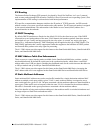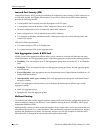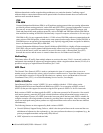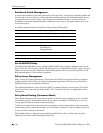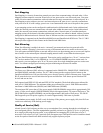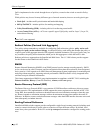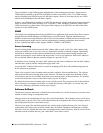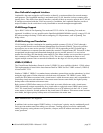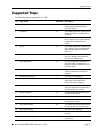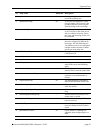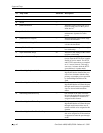
Software Supported
OmniSwitch 6800/6850/9000—Release 6.1.3.R01 page 33
The switch fabric on the CMM operates independently of the management processor. If there are two
CMM modules installed in an OS9700, both fabric modules are normally active. Two CMM modules
must be installed in the OS9700 to provide full fabric capacity. However, note that only the one CMM
module in the OS9600 provides full fabric capacity.
If there is one CMM module installed in an OS9700, then there is a single management feature and perfor-
mance as a dual CMM system, but there is no “secondary” CMM. Hardware or software failures in the
CMM will result in a system reboot. The System fabric capacity on an OS9700 is one half of the fabric
capacity of a dual CMM system.
SNMP
The Simple Network Management Protocol (SNMP) is an application-layer protocol that allows commu-
nication between SNMP managers and SNMP agents on an IP network. Network administrators use
SNMP to monitor network performance and to solve network problems. SNMP provides an industry stan-
dard communications model used by network administrators to manage and monitor their network
devices. OmniSwitch 9000 switches support SNMPv1, SNMPv2, and SNMPv3.
Source Learning
Source Learning builds and maintains the MAC address table on each switch. New MAC address table
entries are created in one of two ways: they are dynamically learned or statically assigned. Dynamically
learned MAC addresses are those that are obtained by the switch when source learning examines data
packets and records the source address and the port and VLAN it was learned on. Static MAC addresses
are user defined addresses that are statically assigned to a port and VLAN.
In addition, Source Learning also tracks MAC address age and removes addresses from the MAC address
table that have aged beyond the configurable aging timer value.
Accessing MAC Address Table entries is useful for managing traffic flow and troubleshooting network
device connectivity problems.
There are two types of source learning modes currently available: software and hardware. The software
mode performs all source learning using switch software. The hardware mode takes advantage of hard-
ware resources that are now available to perform source learning tasks. At the present time, it is possible
to select the mode that is active for the chassis and/or a given set of ports.
By default, hardware source learning mode is active for the switch. The exception to this is that hardware
source learning is not supported on mobile or Learned Port Security (LPS) ports. As a result, only soft-
ware source learning is performed on these types of ports.
Software Rollback
The directory structure inherent in an OmniSwitch switch allows for a switch to return to a previous, more
reliable version of image or configuration files.
Changes made to the configuration file may alter switch functionality. These changes are not saved unless
explicitly done so by the user. If the switch reboots before the configuration file is saved, changes made to
the configuration file prior to the reboot are lost.
Likewise, new image files should be placed in the working (non-certified) directory first. New image or
configuration files can be tested to decide whether they are reliable. Should the configuration or images
files prove to be less reliable than their older counterparts in the certified directory, then the switch can be
rebooted from the certified directory, and “rolled back” to an earlier version.



